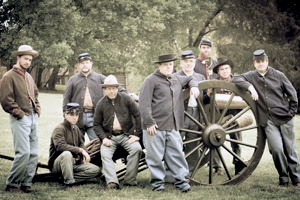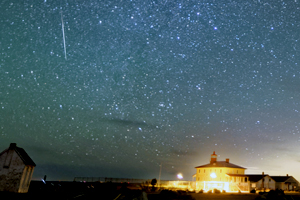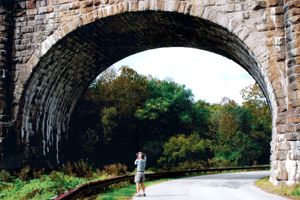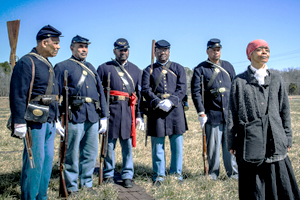Chronicles of the Freedom War: A look at Civil War sites within state parks

Fort Frederick re-enactors; department photo
As a border slave state that remained loyal to the Union, the State of Maryland played a key role in the American Civil War, one of our nation’s most important and bloody conflicts. The Old Line State saw many of the same political and social conflicts over slavery, secession and states’ rights that played out on the national stage. The war itself also spilled into Maryland—most notably during the Confederate invasions in 1862, 1863 and 1864. In fact, it was the Battle of Antietam that transformed the most violent conflict on American soil into a war about freedom for all Americans.
Not surprisingly, there are many federal, state, local and privately-maintained Civil War-related sites in Maryland. Most of the state-owned sites are found within our network of 72 state parks.

South Mountain artillery detachment staff; department photo
South Mountain State Battlefield
The Battle of South Mountain was a key turning point in the Maryland Campaign: a failed Confederate invasion of the North in 1862.
Riding high on a string of victories, Confederate General Robert E. Lee’s Army of Northern Virginia invaded Maryland in September. He hoped a victory on Northern soil might weaken the North’s resolve and help secure Southern independence. But a copy of Lee’s battle plans fell into enemy hands. Union General George B. McClellan learned that Lee had moved his army west of South Mountain, divided it, and left only a few regiments to guard the mountain passes.
Fought on Sept. 14, the Battle of South Mountain occurred in a series of engagements that slowed (but did not stop) the Union charge. The Confederates bought time for Lee to reassemble his army. The fighting on South Mountain, especially in Fox’s Gap, was fierce. In all, 768 men lost their lives and 3,367 were wounded.
After the horrifically bloody Battle of Antietam, fought three days later, Lee was forced to retreat to Virginia. His retreat gave President Abraham Lincoln the opportunity to issue the Emancipation Proclamation—a major step that helped lead to the abolishment of slavery in the United States.
The South Mountain Battlefield museums are located at Washington Monument and Gathland state parks. Battlefield staff regularly host walking tours and living history demonstrations throughout the spring, summer and fall. The grounds are a mixture of federal (Appalachian Trail), state and private lands. Visitors are encouraged to contact the park before exploring the battlefield and to respect private property.

Point Lookout; photo by Xavier Prines
Point Lookout State Park
Situated on a narrow peninsula where the Potomac River empties into the Chesapeake Bay, Point Lookout was the site of a 40-acre prisoner of war camp that housed up to 52,264 Confederate prisoners from 1863 to 1865.
Union authorities established Hammond General Hospital there during the Peninsular Campaign of 1862. After the Battle of Gettysburg in July 1863, however, the federal government began incarcerating Confederate prisoners north of the hospital grounds at the newly constructed Camp Hoffman. Due in part to disease, poor water, an insufficient food supply and inadequate shelter, more than 4,000 captives perished by the war’s end.
Among the federal army units who served as guards at Point Lookout were members of the United States Colored Troops. In a twist of fate, some of these soldiers guarded their former masters.
Scant traces of the prison camp now survive. Most of it is under the bay, but a section of the wall has been reconstructed. An earthen Civil War fort has also been preserved along with the reconstruction of the enlisted men’s barracks, officers’ quarters and guardhouse. A federal-administered cemetery is located north of the park, which also includes a memorial erected by the State of Maryland.
The Point Lookout visitor center features exhibits on the prison camp and hospital, and offers other educational programs for visitors of all ages. The park sponsors historic programs and demonstrations throughout the year and hosts several annual festivals, including Blue and Gray Days.

Patapsco Valley; photo by Thomas Scilipotti
Patapsco Valley State Park
The Thomas Viaduct—a stone-arched railroad bridge crossing the Patapsco River—proved crucial to the Union’s effort to keep its armies supplied and to protect Washington D.C.
The viaduct made-up the first leg of the Baltimore & Ohio Railroad’s Washington Branch, which in 1861 was the only railroad line connecting the federal capital with the rest of the Union. On April 20, 1861, pro-Southern partisans destroyed rail bridges north and east of Baltimore.
To ensure that the Thomas Viaduct did not meet the same fate, a small Union force under the command of Brigadier General Benjamin F. Butler occupied the bridge and nearby Relay Junction in May 1861. Later in the war, three fortifications were built near the bridge to protect it from saboteurs and invading armies.
The circa-1835 railroad bridge is one of the nation’s oldest. It still used by CSX and MARC trains, and is best viewed from the valley floor along the park’s Avalon Area entrance. Locations of the various fortifications surrounding the bridge are on private property and should not be approached without consent.

Fort Frederick; department photo
Fort Frederick State Park
Known more for its role in the French and Indian War, Fort Frederick’s stone fort also played a minor part in Union efforts to protect both the Chesapeake & Ohio Canal and the Baltimore & Ohio Railroad—both vital supply and transportation links for Union troops in the eastern theatre.
On Dec. 18, 1861, a federal company occupied the long-abandoned fort. These troops fought several skirmishes with Confederate raiders over the next month. Few details of these engagements remain. It is known, however that the Union successfully defended the canal and Confederates tore-up a section of the railroad. Federal troops abandoned the fort in late February 1862 but remained in the area for the remainder of the war.
Coincidentally, just before the war, a local free black farmer, Nathan Williams, had purchased the property. The Williams family farmed the land until they sold it to the state in 1922.
The park houses a few Civil War artifacts and hosts an annual Civil War living history weekend—usually in October.

Tubman re-enactors at future park site; photo by Lori Livingston
Additional public sites
Several other state parks also host notable Civil War-related sites, including Gunpowder Falls (Jerusalem Mill and Monkton Station), Susquehanna (Rock Run Historic Area), Cunningham Falls (Catoctin Furnace) and Chapman (Mount Aventine Mansion). Jerusalem Mill hosts a Civil War event every summer—usually noting Confederate Colonel Harry Gilmor’s Raid of 1864. A new state park in Church Creek, dedicated to commemorating the story of Harriet Tubman, is scheduled to open in March.
Article by Robert Bailey—assistant manager at Rocks, Susquehanna & Palmer state parks and former Park Service historian. Appears in Vol. 20, No. 1 of the Maryland Natural Resource magazine, winter 2017


 1-888-373-7888
1-888-373-7888 233733
233733